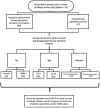HSP70 upregulation in nasal mucosa of symptomatic children with allergic rhinitis and potential risk of asthma development
- PMID: 35982171
- PMCID: PMC9388484
- DOI: 10.1038/s41598-022-18443-x
HSP70 upregulation in nasal mucosa of symptomatic children with allergic rhinitis and potential risk of asthma development
Abstract
Allergic rhinitis and asthma are the most common causes of chronic inflammation of the upper and lower airways in childhood. However, a nasal biomarker that can link to pulmonary inflammation is yet to be found. The present paper aims to investigate the possible role in inflammation of two inducible 70-kDa Heat Shock Proteins (HSP70) members, HSPA1A/B and HSPA6, in nasal mucosa cells of allergic children through their mRNA expression analysis, and their correlation to both spirometric and FeNO values. The relationship between FeNO in lower airways and ∆Cts of HSPA1A/B in nasal mucosa seems to be influenced by clinical symptoms regardless of age, sex, and sensitization patterns. Therefore, HSP70 expression, as well as FeNO levels, could have a predictive capability to identify lower airways inflammation and thus to recognize rhinitic children having a potential risk of asthma development.
© 2022. The Author(s).
Conflict of interest statement
The authors declare no competing interests.
Figures






References
-
- Bousquet J, et al. Next-generation Allergic Rhinitis and its Impact on Asthma (ARIA) guidelines for allergic rhinitis based on Grading of Recommendations Assessment, Development and Evaluation (GRADE) and real-world evidence. J. Allergy Clin. Immunol. 2020;145:70–80. doi: 10.1016/j.jaci.2019.06.049. - DOI - PubMed
Publication types
MeSH terms
Substances
LinkOut - more resources
Full Text Sources
Medical
Research Materials

